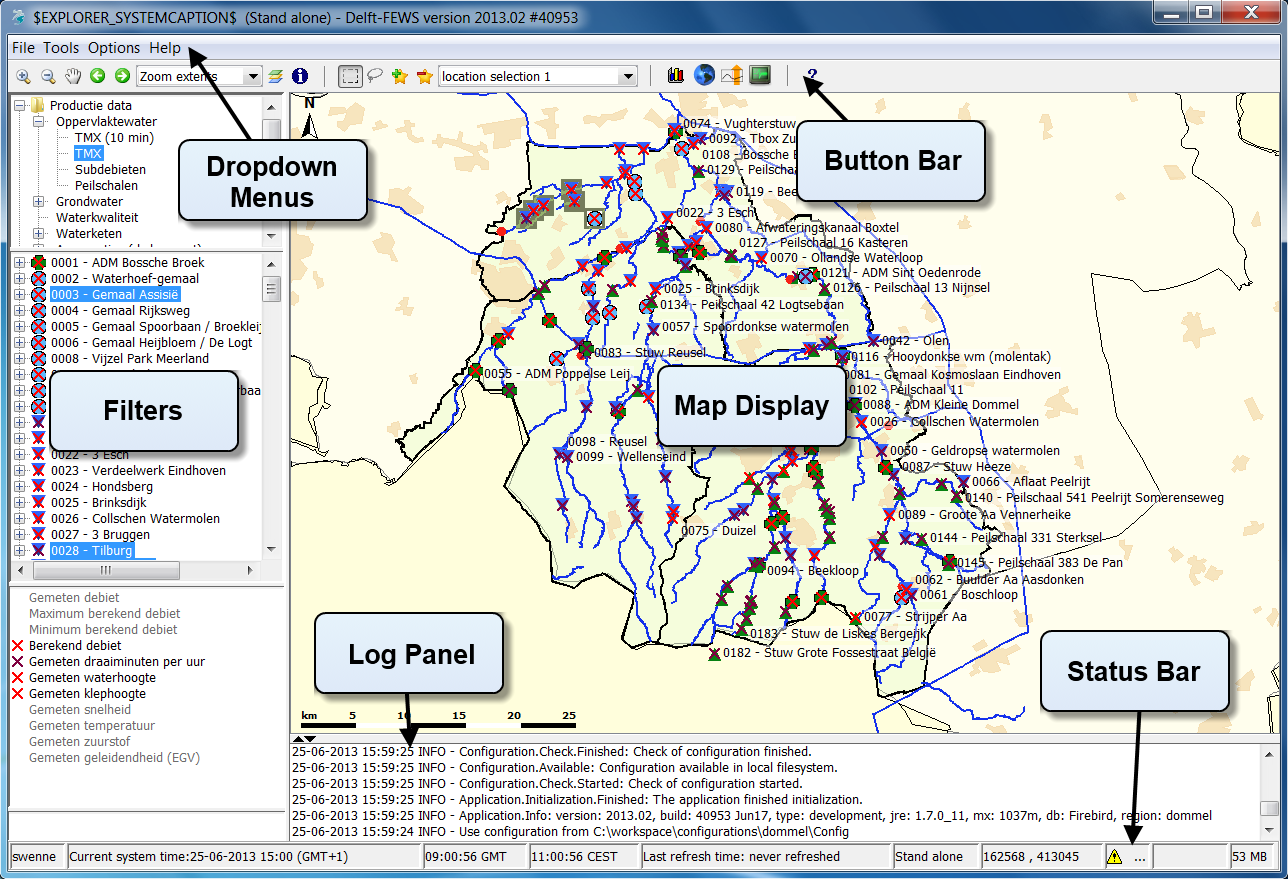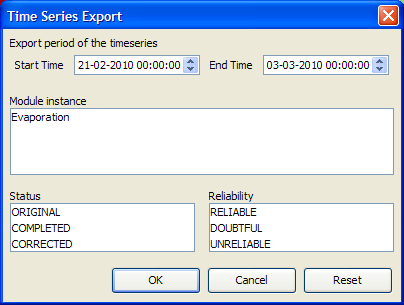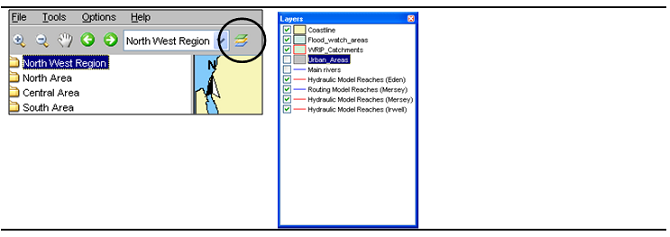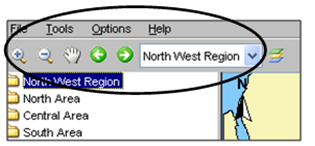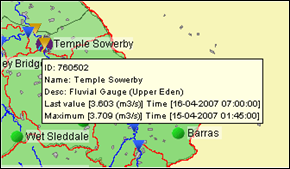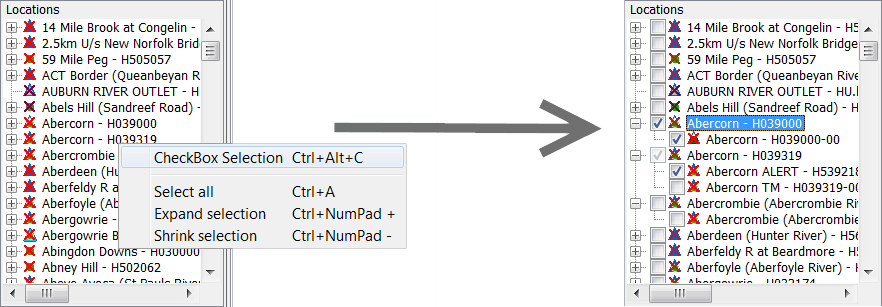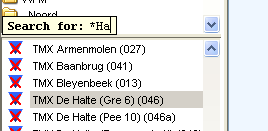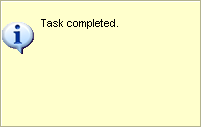| scrollbar |
|---|
<p><br /></p> |
| Table of Contents |
|---|
| Children Display |
|---|
FEWS Explorer
Overview
FEWS Explorer is the principal window main interface of Delft-FEWS. The main elements key components of FEWS Explorer are highlighted emphasized in the figure below. All windows can be re sized manually resized by dragging the mouse, or they can be undocked detached from the main screen, see . For more information, see the section on Dockable Windows in: 23 Interactive Forecasting Displays#23InteractiveForecastingDisplays-Dockablewindows.
Map
...
displays
The map display serves a double purposetwo main functions. The first is to give provide an overview of the available locations given based on a combination of applied filters applied , and to allow the user to select or deselect locations by clicking on the location icon. The second function is to provide a geographical background to context for the locations involved in the flood forecast.
Filters
The list boxes
...
, also
...
known as filters
...
, are
...
necessary to identify the data to be displayed in a graph or table, or the icons on the map. There are four list boxes, listed from top to bottom:
- Time
...
- Series Groups
- Locations
- Data
...
- Types (
...
- Parameters)
- Forecasts
Drop down menus
The drop-down menu bar provides access to all displays that are configured for your configuration specific setup of FEWS.
File - Export timeseries
This menu option opens the Export timeseries dialog.
This dialog can be used to filter the selected timeseries by view period, module instance, reliability and status. After the filter options are selected, the timeseries which match the given criteria are saved to a file.
When the user selects in the Export timeseries dialog the reliability "unreliable", then only export formats that write quality flags are available, i.e. PI xml files, CSV files with quality flags and Dutch CSV files with quality flags.
If "unreliable" is not selected in the export timeseries dialog, then all export formats are available. This is required, because if unreliable values would be exported without quality flags, then it would not be possible in the exported file to see which values are unreliable. In the case of csv format with quality flags, the complete text of the quality flags (including STATE and DETECTION flags, if they exist) are added to the timeseries.
All export formats available in the Export timeseries dialog are:
...
Button bar
The button bar offers quick access to frequently used tools. These tools are plug-ins to the FEWS Explorer. See FEWSExplorer-StatusBar for more information.
Log Panel
The Log Viewer provides high-level messages generated by active system components. For more detailed messages, users can refer to the Log Browser.
Status Bar
The Status Bar provides information about the status of the forecasting system.
Map Display
Locations are displayed on top of the background map. The main filter that is selected determines which locations will be shown. The background map can be configured to consist of a stacked layering of various maps. For each map, details about line types and fill colors can be set. Map layers can be disabled using the “Layers” button on the Button Bar.
Tooltip
Information is displayed when the user moves the mouse cursor over a shape. To view this information, activate the ‘I’ button on the button bar.
Map navigation
Map navigation options are set in the zoom toolbar item. After clicking the ''button you can manually zoom in to a user defined map area. With the '-' button you can zoom out. Panning is possible after having clicked the hand button. After selecting the '' button, drawing a box from top left to bottom right zooms in, while bottom right to top left zooms out. Holding down the right mouse button allows you to pan. The buttons for zoom out and pan remain for users with only one mouse button. Returning and moving forward between previously selected zoom extents can be done after clicking the arrow buttons. The drop-down allows you to select pre-defined zoom ranges. Please note that in case you want to leave the zoom or pan mode, you have to click the buttons again.
Zooming with scroll wheel
Alternatively, zooming can be performed using the scroll wheel on the mouse, if available. Zooming in and out is achieved by turning the scroll wheel away from or towards the user, respectively. The position of the cursor determines the center point of the zoom action.
Distance ruler
With the ruler button you can measure a distance on the map.
Selecting locations and parameters
Locations in the Map Display can be selected by clicking on their respective icons. When a location is selected this way, the locations selected in the Filters (located to the left of the map display) will be adjusted to match the map display. Conversely, if a location is selected in the Filters, the selection in the Map View will be adjusted accordingly. Multiple locations can be selected by holding down the [CTRL] key while making selections.
Parameters can be selected in the filter box located below the locations filters. It’s also possible to select multiple parameters by holding down the [CTRL] key while selecting.
In the Button Bar, there is a section further aiding location and parameter selection ()
Icon | Description |
Rectangle selection: When selected allows you to press left mouse button and drag to create a rectangular box over the Map Display. When released it will select all locations contained in the rectangle. | |
Lasso selection: It allows you to create a freehand selection in the Map Display. To do this, press and hold the left mouse button and drag it around the locations you want to select. Release the mouse button to finalize the selection. |
There is also a button bar in the Data Viewer which allows storing selections you wish to reuse later.
Icon | Description |
Add selection: Stores the current filter, location and parameter selection. A Pop-up will allow you to enter a name for this selection. After entering the name and pressing OK, the selection can be found in the dropdown box to the right. | |
Remove selection: Removes the current item in the saved selection dropdown box to the right of this icon. If there is no current item, or it is empty, nothing will happen. | |
Saved selection dropdown: When an item from this list is selected, the filters, locations, and parameters contained in that item will be chosen in the Map Display and Data Viewer. Selections can be added or removed using the ‘Add/Remove location selection’ buttons |
The stored selections persist through a restart of FEWS and can only be deleted by manually removing them or when overwritten. These selections are saved in the user settings and will not be visible to other users. The toolbar in the Data Viewer can be concealed to save space by right-clicking on one of the trees in the Data Viewer. The right-click menu includes a ‘Show Toolbar’ option.
Show map layer information
An icon on the toolbar can be clicked to enable the display of information for map layers as a tooltip. If a map layer is configured to display information from the .dbf file, a user can reveal this information by clicking the information button. If the zoom mode is activated, the desired location will not be selected; instead, the map will be panned. The zoom or pan mode must first be deactivated by clicking the magnifying glass icon again.
When the cursor is moved to a location, a tooltip will be displayed with the following information:
- Location ID
- Location name
- Site description
- Information about time series
- Last available value and date & time of the last value
- Maximum value (in the view period) and date & time of the maximum
An example is provided below:
| Info |
|---|
The tooltip shown above is the default tooltip. Within Delft-FEWS, it’s possible that the tooltip has been configured differently, for example, to display a picture of the location. Consult the documentation of your local system or the Delft-FEWS configuration guide (locations) for more information. |
Filters
The filters are the four list boxes located on the left-hand side of the FEWS Explorer. These filters are used to select the data to be displayed in a graph or table. Your selection can be refined by making one or more choices in these list boxes.
Using Check box selection
Locations, parameters, and qualifiers can be selected using checkboxes. To do this, right-click on the windows for which you want the checkbox selection and select ‘Show checkbox selection’.
With checkbox selection, clicking the label does not select the item. You will need to check the checkbox to select the item. A greyed-out selected checkbox indicates that one, but not all locations associated with the local branch (the parent and its children), are selected. As in the normal selection mode, it is possible in checkbox mode to select only the children without selecting the parent.
Visibility of locations and parameters
The context menu of the list boxes includes the option ‘Show only selected’ [CTRL ALT O]. This option limits the visibility of locations and parameters in the list box to the elements that are selected when this option is chosen. In the case of locations, the visibility on the map is also limited. The visibility of all elements can be restored using the ‘Show All’ option [CTRL ALT A]. It should be noted that these options require the list box tree to be rebuilt; in checkbox selection mode, this results in all children collapsing, except for the element with focus (indicated by a dashed box).
Selection of location types
Time series sets can be selected in the upper filter. These sets are configured groups of locations with similar data types. The locations associated with the selected time series set(s) will be displayed on the Map Display and listed in the Locations Filter, the second list box. The data types associated with the locations are displayed in the Data Types Filter, the third list box.
To select multiple locations from a list, hold down the [SHIFT] key between the first and second selection. Hold down the [CTRL] key to individually select multiple location types.
By using the right mouse button or a shortcut key, some context menu options become available:
- Select All [CTRL A]: Selects all locations.
- Expand Selection [CTRL Numpad +]: A popup is displayed where the selected locations can be expanded using a wildcard search. The wildcard characters are ‘', matching zero or more characters, and ‘?’, matching exactly one character. All matching locations will be selected. For example, ‘Maas km 1?.00’ will match ‘Maas km 10.00’, ‘Maas km 11.00’, etc., but not ‘Maas km 101.00’. As another example, 'Maas km 1’ will match ‘Maas km 10.00’, ‘Maas km 11.00’, etc., and also ‘Maas km 100.00’, ‘Maas km 101.00’, etc.
- Shrink Selection [CTRL Numpad -]: A popup is displayed where the selected locations can be shrunk using a wildcard search (using * and ?). All matching locations will be deselected
Locations list box
The locations associated with the selected main filter(s) are displayed in the locations filter. Selected locations are highlighted on the map with a blue square. You can also select locations directly on the map.
Location-related icons appear both on the map and next to the location names, providing information about data availability and hydrological status. More details about these icons are provided in a separate section.
The location list box has a context menu, which includes options such as "Hide Unselected Outside Map". When this option is checked, the list updates as you pan or zoom the map.
You can filter locations based on data availability. For example:
- "Currently available" shows locations with data within the configured view period of the filter.
- "Somewhere available" shows locations with data either within or outside the configured view period of the filter.
- "Only doubtful and unreliable" shows locations with unreliable or doubtful data within the configured view period, useful for manual validation.
...
Since 2015.01 from the Reliability list, MISSING can be selected. Missing values will only be exported if MISSING has been selected.
Button bar
The Tool bar provides quick access to frequently used tools. Tools are plug-ins to FEWS Explorer. See FEWSExplorer-StatusBar for more information.
Log Panel
The Log Viewer relays high level messages generated by active system components. Additionally, detailed messages are available in the Log Browser.
Status Bar
The Status Bar provides information about the status of the forecasting system.
Map Display
Locations are displayed on top of the background map. The selected main filter determines which locations will be displayed. The background map may be configured to consist of stacked layering of various maps. For each map details about line types and fill colours may be set as well. Map layers can be disabled via the Layers button on the Button Bar..
Tooltip
Information that is displayed when the user is moving the mouse cursor over a shape. To see this information turn on the 'I' button, in the button bar.
Map navigation
Map navigation options are set in the zoom toolbar item. After clicking the ''button you can manually zoom in to a user defined map area. With the '-' button you can zoom out. Panning is possible after having clicked the hand button. From version 2008-01 the zoom in, zoom out and pan have been combined. After selecting the '' button, drawing a box from top left to bottom right zooms in, while bottom right to top left zooms out. Holding down the right mouse button allows you to pan. The buttons for zoom out and pan remain for users with only one mouse button.
Returning and moving forward between previously selected zoom extents can be done after clicking the arrow buttons. The drop-down allows you to select pre-defined zoom ranges.
Please note that in case you want to leave the zoom or pan mode, you have to click the buttons again.
Zooming with scroll wheel
Alternatively, zooming can be done with help of the scroll wheel on the mouse (when available). Zooming in and out is done by respectively turning the scroll wheel away and towards for the user. The position of the cursor determines the centre point of the zoom action.
Selecting locations and parameters
Locations in the Map Display can be selected by clicking on their icon. When selecting a location in this fashion, the locations selected in the Filters (to the left of the map display) will be adjusted to correspond with the map display. Conversely, if a location is selected in the Filters, the selection in the Map View will be adjusted as well. Multiple locations can be selected by holding down the [CTRL ] key while selecting.
Parameters can be selected in the filter box bellow the locations filters. It's also possible to select multiple parameters by holding down the [CTRL ] key while selecting.
In the Button Bar, there is a section further aiding location and parameter selection.
Rectangle selection: When selected allows you to press left mouse button and drag to create a rectangular box over the Map Display. When released it will select all locations contained in the rectangle. | |
Lasso selection: When selected allows you to create a freehand selection in the Map Display. Press and hold the left mouse button and drag around the locations you want selected. Release to make the selection. | |
| Select with map item selection: When selected allows you to select polygons on the Map Display. When hovering over a polygon, the polygon will be highlighted. If clicked, the locations related to the polygon will be selected. | |
Add location parameter selection: Stores the current Map Display location and parameter selection. A Pop-up will allow you to enter a name for this selection. After entering the name and pressing OK, the selection can be found in the dropdown box to the right. | |
Removes location parameter selection: Removes the current item in the location and parameter selection dropdown box to the right of this icon. If there is no current item, or it is empty, nothing will happen. | |
Location parameter selection dropdown: When selecting an item from this dropdown, the locations and parameters contained in that item will be selected in the Map Display and the Filters. Selections can be added or removed with the Add / Remove location selection buttons. |
The stored selections endure a restart of FEWS and will only be deleted by manually removing them or when overwritten.
Show map layer information
An icon on the toolbar can be pressed to activate the presentation of information for map layers as a tooltip. If a map layer has been configured such that it shows information from the dbf file, a user can show this information by clicking the information button.
Note
In case the zoom mode has been activated, the desired location will not be selected, but the map will be panned instead. The zoom or pan mode must first be deactivated by clicking the magnifying glass again.
When moving the cursor to a location, a tool tip will be displayed with the following information:
- Location ID
- Location name
- Site description
- Information about time series...
- Last available value and date & time of last value
- Maximum value (in view period) and date & time of maximum
An example is given below;
| Info |
|---|
The tooltip shown above is the default tooltip. Within Delft-Fews it is possible that the tooltip has been configured differently to e.g. display a picture of the location. Consult the documentation of your local system or the Delft-Fews configuration guide (locations) for more information. |
Filters
The filters are the 4 list boxes at the left hand side of the FEWS Explorer. The filters are used to select the data to be displayed in a graph or table. Your selection can be filtered by making one of more choices in the list boxes.
Using Check box selection
Locations, parameters and qualifiers have the ability to be selected with check boxes. To do so, right click on the windows for which you want the check box selection and select "Show check box selection".
With check box selection, selecting the label does not select the item. You will have to check the checkbox to select the item. A greyed out selected checkbox means that one, but not all locations associated with the local branch (the parent and its children) are selected. Like in the normal selection mode, it is possible in check box mode to select only the children without the parent.
Visibility of locations and parameters
The context menu of the listboxes includes the option Show only selected [CTRL ALT O]. This option restricts the visibility of locations and parameters in the listbox to the elements that are selected at the moment this option is chosen. In case of locations, the visibility in the map is also restricted. The visibility of all elements can be restored using the option Show All [CTRL ALT A]. It should be noted that these options require the listbox tree to be rebuilt; in check box selection mode, this leads to collapsing all children, except for the element with focus (dashed box).
Selection of location types
Time series sets can be selected in the upper filter. Time series sets are configured groups of locations with similar data types. The locations with the selected time series set(s) will be displayed on the map display and listed in the locations filter, the second list box. The data types associated with the locations are displayed in the data types filter, the third list box.
To select a list of multiple locations, hold down the [SHIFT ] key between the first and second selection. Hold down the [CTRL ] key to select multiple location types individually.
Using the right mouse button or a shortcut key, some context menu options become available:
- Select All [CTRL A] : Select all locations.
- Expand selection: [CTRL Numpad +] : A popup is shown where the selected locations can be expanded using a wildcard search. The wildcard characters are "*", matching zero or more characters, and "?", matching exactly one character. All matching locations will be selected.
For example, "Maas km 1?.00" will match "Maas km 10.00", "Maas km 11.00", etc., but not "Maas km 101.00".
As another example, "Maas km 1*" will match "Maas km 10.00", Maas km 11.00", etc., but also "Maas km 100.00", Maas km 101.00", etc. - Shrink selection: [CTRL Numpad -] : A popup is shown where the selected locations can be shrunk using a wildcard search (using * and ?). All matching locations will be deselected.
Locations list box
The locations associated with the selected main filter(s) are shown in the locations filter. Selected location will be highlighted on the map by means of a blue square. Locations can also be selected in the map display.
Location related icons are displayed on the map as well as in front of the location names.
Different icons are used to display locations and give information about the availability of data and about the hydrological status of the locations. More information about location related icons is given below in a separate section.
Data types list box
The data types associated with the selected main filter(s) are shown displayed in the data types list box.
Selecting one or multiple data types causes the location list box to be updated regarding the potential availability of data, as shown by the icon displayed to the left of the location.When depending on the selections made updates the location list box, indicating potential data availability with an icon next to each location. If no data is available for a particular location or parameter based on the selections, its name is greyed out.
To select a list of multiple data types, hold down the [SHIFT ] key between the first and second selection. Hold , or hold down the [CTRL ] key to select multiple data types individually.
Using the right mouse button or a shortcut key, some the following context menu options become available:
- Sort by name: Sort all data types by name.
- Select All [CTRL A]: Select all data types.
- Expand selection :
- [CTRL Numpad +]: A popup is shown where
- Open a popup to expand the selected data types can be expanded
- using a wildcard search ( using
- e.g., * and ?). All matching data types will be selected.
- Shrink selection :
- [CTRL Numpad -]: A popup is shown where
- Open a popup to shrink the selected data types can be shrunk
- using a wildcard search ( using
- e.g., * and ?). All matching data types will be deselected.
Forecast list box
The forecast list box displays forecasts that have been selected for viewing with help of via the Forecast Manager. By highlighting Highlight one or more forecasts in this filter you can to display them in graphs and tables.
Please note that- although Although not visible in the forecast list- , the current forecast is always selected by the system. Icons related to the current forecast will be displayed appear on the map. The current forecast will also always be , and it is always shown in the time series display. Selection of Details on selecting the current forecast is described in the section about are provided in the Forecast Manager section.
The To remove the selection of forecasts in the Forecast forecast list box can be removed by clicking the right mouse button with the cursor placed in the forecast list box. A , right-click within the box to bring up a pop-up menu appears with . Select 'Remove all' . Pressing this menu item will remove to clear the list of forecasts from the list box. Please note that this will just remove the selection but will not remove . This action only removes the selection, not the actual forecasts from the database.
Location related icons
Locations Location-related icons can refer to the following types of information:
- Location type icons
- Data availability icons (validation information)
- Hydrological status icons (threshold information)
Location type
For different types of locations different , various icons can be configured to allow for easier identification. Please note Note that only a single one location type icon can be defined per location. In case for example various data types are available at a certain location that relate If a location has multiple data types related to different icons, the a choice has to must be made for which icon will be displayed.
In Delft FEWS, the following location icons have been chosen, but in principle, any icon could can be chosen selected to represent a location type in FEWS.
Icon | Description |
gauged fluvial site |
ungauged fluvial site | |
meteorological site |
radar data site |
coastal site |
catchment |
center point | |
default site |
Data availability and validation
Data availability icons show what kind of data is available for the timeSeries selected in a filter.
Icon | Description |
no data stored in database (also when looking outside of the view period) |
only missing values available in view period |
only missing values available in view period for some time series (configurable since 2011_02; see someSeriesCompletelyMissingIconVisible in the Explorer file) |
some missing values available in view period |
soft validation limit exceeded |
hard validation limit exceeded |
data edited or interpolated |
| Info |
|---|
Although the icon descriptions are always truegenerally accurate, there are some common assumptions that about them are not always correct. Following Here are some a few examples and an elaboration with details why it's not true.-with explanations:
|
If both a data availability icon and validation icon are valid - both will be shown concurrently. By default only the red crosses are shown; add the tag to the Filters file to display the additional validation icons.
Hydrological and meteorological status
In case the high flow thresholds or rainfall thresholds are exceeded somewhere in within the configured view period, the following icon is displayed.:
Icon | Description |
a threshold exceeded in view period |
The threshold status icons are displayed only displayed for the current forecast or , selected forecast, and observed data.
Together with the threshold These icons provide information is displayed on the map to inform the forecaster onabout:
- the
- The timing of the threshold crossing (historic or forecast period) ,the
- The severity of the threshold crossing .
There are 5 extra five additional icons pre-configured for 5 five threshold levels that , which are merged with the original threshold icon. These extra icons are:
Icon | Description |
Level 1 threshold crossing in historic and forecast period |
Level 2 threshold crossing in historic and forecast period |
Level 3 threshold crossing in historic and forecast period |
Level 4 threshold crossing in historic and forecast period |
Level 5 threshold crossing in historic and forecast period |
For a level 3 threshold crossing in the historic period the combined threshold icon for a location will look as follows:
One can toggle the threshold icons using a specific button. When this button is activated, the threshold icons are displayed on the map as usual. When the button is deactivated, the threshold icons are hidden, allowing the location type and data availability and validation icons to become visible. This button can be recognized by its icon: .
Search in list boxes
It is possible to search elements in the list boxes. Select the appropriate list box and start typing the search criteria, see examples below. The cursor jumps will jump to the next element starting that starts with the letters you typed; in determining a match a , with an implied closing asterisk "*" is implied. You may .
You can also use the asterisk asterisk "*" explicitly in explicitly in the search criteria , for example if if you do not want to start with the first character of the elements in the list box. When If the search criteria turns turn red, the search criteria can not it means that no matching element can be found.
...
...
Examples:
- Typing "ca" will jump to the first element starting with "ca".
- Typing "*house" will find elements containing "house" anywhere in their name.
By using the up and down arrow keys, you can jump navigate to the next element in the list boxes that match matches the search criteria.
Log Viewer
The Log Viewer provides information about the status of tasks run by the system. The messages that are displayed by the Log Viewer- , called System Messages- , are meant intended for both end users and system managers. Typical system logs are These messages typically include logs related to the successful start and finish of a module run.
The following type types of system messages are identified:
Log level | Description |
|---|
FATAL | Severe errors that cause premature termination |
ERROR | Other runtime errors or unexpected conditions |
WARN | Events that are undesirable or unexpected, but not necessarily wrong |
INFO | Runtime events (startup/shutdown) that allows tracking of the progress of the system |
Per For each message, the Log Viewer provides the following information:
- Log level ( see
- refer to the table above)
- Time of creation
- Event code
- Log message
Further sorting and assessment of the messages can be done with the help of the system System Monitor (see also refer to System Monitor for more details).
A System Manager can configure the system to also provide Debug Messages. These messages are used to log application internal events for system development and management. Typical debug events are include the creation of a database connection or exceptions that occurred due to programming or configuration errors.
All messages listed in the Log Viewer can be removed from the display (but not from the Local Data store) clicking the right mouse button by right-clicking with the cursor placed in the Log Viewer panel. Two options are available:
- "Clear Messages": Removes all messages from the panel.
- "Save As": Allows you to save the messages in the Log
...
- Panel to a file.
Tabs
The "Open At Startup" menu item is available to users, allowing them to specify whether a tab should open automatically when the application starts. If the tab is already configured to open at startup through explorer configuration, this menu item will not be available.
In addition, the last selected panel in a schematic status display is now saved in the user settings.
...
Status Bar
The Status Bar provides information about the status of the forecasting system. The information that is displayed can be defined by the user users with real-time updates on the forecasting system's status. Users can customize the information displayed via the Options menu (see also Options ). Some default information is always visible .The following information can be displayedincludes:
Operator name (always displayed)
The name of the operator that has logged in is displayed.
Current system time
The current system time is represents the live operational time in which of the system 'lives'. The current system time moves forward in the so-called "Cardinal Time Step". In the live system the current system time will generally be the same as the current time. For analysis purposes, the system time can be set back in the standalone system to simulate a particular situation in the past, progressing in cardinal time steps. Typically, in live operation, the system time aligns with the current real-world time. However, for analytical purposes, users can manipulate the system time in a standalone environment to simulate past scenarios.
When the system time is set backadjusted backward, only information - e.g. observed data and external forecasts- will be available to the system with a time stamp before the set system time. In case an hindcast for a particular flood is made with the system time set back to for example with timestamps preceding the set system time is accessible to the system. For instance, if the system time is set to 13:00 on January 21 January 2004, only data, that where imported into the database before this time will be used by the system. The system behaves as if the current time was 13:00 on 21 January 2004. When part of the required import data streams were missing at that moment but have been received later, they are not used in the analysis.
In case however, the same analysis is done without setting back the system , all data until the current time will be available for the analysis. This means that in this case also the above mentioned missing import data will be used in the analysis.
FEWS time
, 2024, any observed data or external forecasts imported before this timestamp are utilized in the analysis. Any data received after this timestamp, even if it fills gaps in the historical record, is not considered for analysis.
Conversely, when conducting analyses without adjusting the system time, all available data up to the current system time is utilized. This includes any data received after the simulated time in the backward-adjusted scenario, providing a more comprehensive dataset for analysis.
If configured, a "pause" button is visible that allows the user to freeze the current system time, even on an OC.
Background colors current system time
Purple: Indicates that the application is actively updating icons in the data viewer or map. The background turns purple during this process.
Yellow: Indicates that the application is currently updating icons in the Interactive Forecast Display (IFD) or Forecast tree.
Terracotta: Indicates that the system time within the application has been pausedThis is the time that is configured in FEWS to display information.
Local time
The actual computer time. This is the time the user configures in the regional settings of windows.
GMT time
If configured, also the current time in GMT is presented.
Time of last refresh (only relevant for OC)
The time of last refresh indicates the last time the local data store has been synchronised with the Central Database. Not relevant for Stand alone FEWS configurations.
System status
The system status indicates in what the current operating mode of the system is currently operating: online , or stand-alone.
In the live system, the following colour information indicates color codes indicate the state on synchronisationof synchronization:
- In case the colour is red, the
Red: Indicates that the OC is logged off
:
.
Soft purple: Indicates that
In case the colour is soft purple, the OC is
synchronising synchronizing with the MC displayed in the system status box
:
.
Soft green: Indicates that
In case the colour is soft green, the OC is logged on and fully
synchronised synchronized with the MC displayed in the system status box
:
.
Tomato: Indicates that
In case the colour is tomato, the OC is running the Rolling Barrel (system maintenance)
in order to remove expired data from the local
datastoredata store.
- In case the colour is orange, the MC
Orange: Indicates that the MC, to which the OC is logged
into in, is in failover mode, either manually or because the FSS
's are down.
...
Mouse coordinates
Mouse coordinates displayed in the configured coordinate system
System status icon (always displayed)
The System status icon- , located in the lower right corner of the display- , indicates whether the system operates is operating normally or that encountering severe errors are encountered. The icon has the following display modes:
| Icon | Color | Description |
|---|
| Green | System is running normally but warnings have been encountered. |
| Yellow |
| The system has encountered severe errors in the past 48 hours. This |
| indicates that at least one system message |
| with log level ERROR has been generated. |
| Once all messages with this log level have been acknowledged by the user via the System Monitor |
| , the icon |
| will turn green again. |
| Red |
| The system has encountered fatal errors in the past 48 hours. This |
| indicates that at least one system message |
| with log level FATAL has been generated. |
| Once all messages with this log level have been acknowledged by the user via the System Monitor |
| , the icon |
| will turn green again. |
...
Notification (default disabled)
Since 2007.02, the The Explorer can be configured to provide display a popup type notification to show upon completion of manually dispatched tasks. The popup appears This notification appears in the lower left corner of the screen corner, reporting the indicating the name of the job dispatched as well as its success or failure. dispatched job and whether it was successful or unsuccessful.
